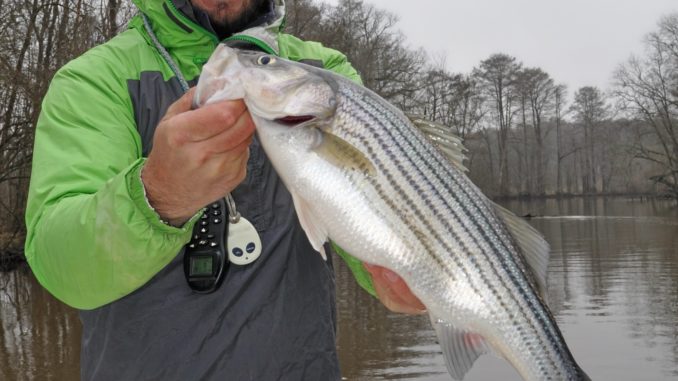
Take a good look at the Three Sisters and cuddle up to a nice, prespawn striped bass.
Some angler think striper fishing in the Roanoke River begins around March 1 each year, because that’s when the keeper season opens on the Roanoke River and in the Albemarle Sound.
They’re wrong.
Although fishermen have to wait, by law, until March arrives to catch “rockfish” on the river and sound, plenty of anglers get a head start on the action in the lower section of the river and the Albemarle Sound, where a great catch-and-release fishery exists that many fishermen don’t know about.
No matter white, however, the lower section of the river is the place to be when the green flag drops on the March 1-April 30 season, which features a two-fish daily creel limit.
Fishing guide Richard Andrews of Bath spends a tremendous number of days on Roanoke waters, fishing for stripers year-round in the river’s vast flood plain. March is when the spawning migration begins at the mouth of the river, as rockfish begin their trek toward Weldon, 120 miles to the northwest in Halifax County
“But it’s a misconception to believe the river doesn’t have stripers all year,” said Andrews, of Tar-Pam Guide Service. “Schools of fish are scattered all winter between the sound and Williamston. You can catch them, if you don’t mind being out in the weather.”
Striped bass roam up and down the Roanoke through the winter and early spring, he said, trying to find baitfish.
“Stripers may be concentrated right at the river’s mouth — or not,” he said. “They might be up the river or in the sound. Wherever they are, they’re just following bait, mainly herring.”
And no matter where fishermen chunk lures or soak baits this month, they have the choice of more bites or bigger fish.
“The stripers in the sound are usually smaller, but they bite better,” Andrews said. “You can catch 100, 200 fish in a day. Sometimes it’s crazy.
“But in the (Roanoke) and the two other streams at the mouth, the Cashie and Eastmost (rivers), and in feeder creeks and guts, you’ll also have stripers, and they’re generally a little bigger. You can have just as good numbers and catch a lot of fish.”
Stripers that anglers catch during late February and early March at the lower Roanoke system will be males or smaller females. Andrews said they’ll range from 18 to 22 inches long and weigh from 2 to 4 pounds.
“The big females that come up the river to spawn around the Weldon area in April and May are ocean fish,” he said. “The fish that hang out all winter in the river and the sound are resident fish.”
After growing large enough, females spawned in the Roanoke eventually make their way out of North Carolina’s sounds and into the ocean. When they reach sexual maturity, they return to the river.
One of the best places to find concentrations of early-spring rockfish is the “Three Sisters” area south of Cashoke Landing. The Three Sisters are the Roanoke, Cashie and Eastmost rivers, which meander through a swampy delta before spilling into Albemarle Sound at Batchelor Bay.
The Cashie flows through the town of Windsor in Bertie County, while the Eastmost connects to the bay a few miles south of the Cashie. The Roanoke is the southernmost of the rivers, each of which rolls beneath bridges spanned by NC 45/308.
“The Roanoke also has little tributaries — Cow’s Creek, Devil’s Gut and Broad Creek — that go through the swamps and contain fish,” Andrews said.
Those creeks are west of the Sisters and northeast of Jamesville. They twist through swamps that make up a large chunk of the Roanoke River National Wildlife Refuge.
“You can catch stripers in all those creeks in March,” Andrews said.
Stripers follow blueback herring that spawn in the swamps. It’s been said that a striped bass will swim a mile to eat a herring, passing up all other baitfish.
“Stripers key on herring,” Andrews said. “As winter progresses into March, the herring spawn in the swamps. They’re looking for flooded timber to spawn.”
Striped bass, he said, are marauders in the streams that meander through the swamps.
Although the N.C. Division of Marine Fisheries and the N.C. Wildlife Resources Commission placed a moratorium on netting of herring in 2007 because the stock had collapsed, Andrews said enough herring make an annual migration into the lower Roanoke to draw the attention of rockfish.
“I personally think there’s still a strong herring run in the Roanoke,” he said, “enough to make it interesting to (stripers).”
As the Three Sisters approach the bay, they widen to resemble traditional coastal rivers.
When he’s hunting for stripers, Andrews idles on his outboard motor, looking for stripers marking on his depth finder, then drops his trolling motor when he locates fish.
His terminal tackle includes leadhead jigs fitted with 3- to 5-inch Z-Man soft-plastic paddletails or Fluke-style baits that he rigs on 3/8- and 1/2-ounce jigheads, depending on current strength. In swamp creeks, he hops them off the bottom after casting at cypress sloughs that spill black water into channels.
“The stripers know the herring are moving in and out of the swamps,” he said. “If you throw a lure up next to a tree and hop it back to the boat, it’ll drop off quick into a creek channel. That’s where fish are.”
When he fishes wide sections of a river, he cruises parallel to the shoreline, where river currents push baitfish against the sides of “humps.” Stripers are readily detected on his depth finder.
“In the river, I just throw a lure near the top of a hump, then bounce it down the side,” he said.
Lure colors depend upon clarity of water.
“I like white and off-white colors when the water is clearer more than 2 feet below the surface,” said Andrews, who chooses pearl/blue glimmer with blue flecks, coconut ice/glow and opening night colors.
“(Lures) also come in a holographic (clear) color with glitter in it,” he said. “Solid pink works well in clear, muddy or black water.”
Andrews’ first choice for stained water is the popular chartreuse/pink color known as electric chicken.
“The chicken color is gaudier when the water’s muddy,” said Andrews, who prefers a 3000-class Shimano spinning reels mated to 7-foot medium- to light-action Temple Fork Outfitters rods. His line is 10-pound Sufix braid with a leader of 17-pound fluourcarbon.
“I use a Uni knot to tie the braid to the fluorocarbon, then I tie a loop knot to the jig,” he said. “The loop knot gives jigs more action.”
Although action this time last year was frantic at times, the fish generally were small, but Andrews said he anticipates bigger fish.
“Size of stripers depends on the dominant age-class of a few years earlier,” Andrews said. “Each year is a little different. Those 13- to 18-inch fish, which came from a big 2011 year- class, will be 18 to 22 inches this year.”
Detecting a spring rockfish bite takes a good feel with a rod because fish normally don’t slam lures — unless they swallow a lure before an angler feels the fish.
“You’re usually just hop jigs off the bottom,” Andrews said. “Flick your wrist to cast and let it fall, then start hopping it. They’ll almost always hit a bait on the fall.
“You’ll feel a little ‘tick’ on the line and that’s when you jerk up hard, as soon as you feel that tick.”
DESTINATION INFORMATION
HOW TO GET THERE — Take US 64 east to reach most Roanoke River ramps. One popular ramp is on NC 45 north of Plymouth and one is on Water Street in Plymouth. For fishing swamps, put in at the Astoria Ramp on Astoria Road north of US 64 Business in Jamesville.
WHEN TO GO — Keeper season for stripers runs March 1-April 30, but on the lower Roanoke and its tributaries and Albemarle Sound, good catch-and-release fishing is common in February.
BEST TECHNIQUES — Bass tackle — baitcasting or spinning gear — spooled with 10-pound braid and 2 feet of 17-pound-test fluorocarbon leaders with a 3/8- to 1/2-ounce jighead and a 3-inch paddletail or 4- to 5-inch Fluke-style lure. The most-effective lures mimic blueback herring colors.
FISHING INFO/GUIDES — Richard Andrews, Tar-Pam Guide Service, 252-945-9715, www.tarpamguide.com. See also Guides and Charters in Classifieds.
ACCOMMODATIONS — Holiday Inn Express-Plymouth, 800-315-2605; Sportsman’s Inn, Plymouth, 252-793-3095; Hampton Inn, Williamston, 855-271-3622; Econo Lodge, Williamston, 800-997-5148.
MAPS — GMCO’s Chartbook of North Carolina, www.gmcomaps.com; Delorme’s North Carolina Atlas & Gazetteer, 800-561-5105, www.delorme.com.

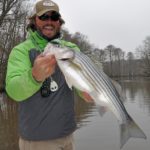
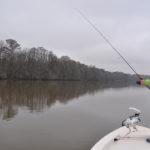
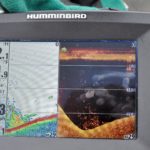
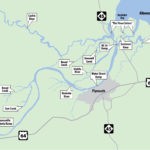



Be the first to comment